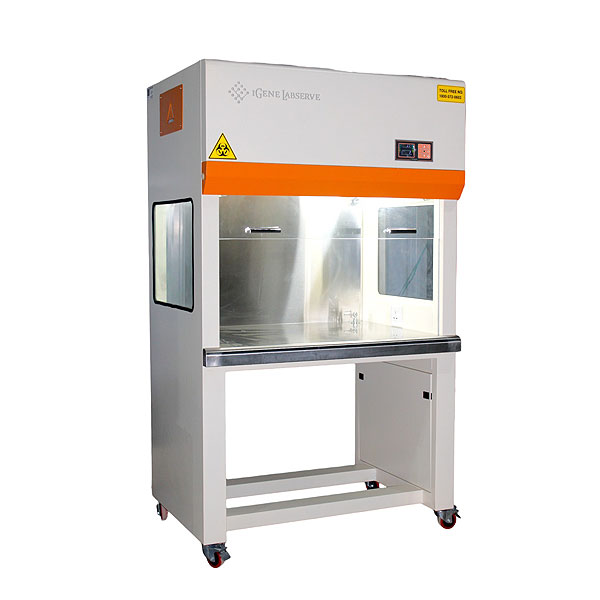A Laminar Air Flow is contamination preventing enclosed chamber used for samples like wafers, biological specimens, and sensitive particles. The chamber serves extensively in tissue culture applications. HEPA filters drive the device’s mechanism by smoothly blowing air inside the chamber. The airflow moves toward the user, which protects the sample from contamination. An ideal laminar airflow cabinet uses a fully airtight stainless steel construction without gaps or joints. Gaps and breaks in partitions can allow spores to grow and contaminate the samples inside the chamber.
Laminar Air Flow hoods come in two types: vertical and horizontal. Installing a UV Germicidal Lamp and keeping it on for 15 minutes effectively sterilizes the cabinet’s interior and protects the samples. However, during operation, the user must switch off the UV light as part of standard laminar airflow precautions. This is because direct exposure to UV light can damage the eyes, leading to cataracts, and may also cause skin cancer.
Who uses Laminar Airflow Cabinets, and where do they use them?
Therefore, the use of the device is particularly significant for maintaining a contaminant-free environment. Life science and research laboratories, microbiology, histopathology or pathology labs, plant tissue and cell culture labs, the pharmaceutical industry, and even the electronics industry use it. The laminar airflow applications are highly effective in reducing and controlling viable and nonviable particulates. In microbiological labs, hazardous particulates can invade the human body because they naturally target specific tissues and organisms, putting lab workers at risk.
What parts does the Laminar Airflow Cabinet Chamber include?

The cabinet
The insulated stainless steel cabinet maintains a sterile environment within the hood and protects the samples from external particle contamination. A glass shield encloses the front part and provides an access point, allowing users to operate the system through a partial or complete opening.
Work station
The solid flat working space within the chamber allows the user to carry out investigations and studies on specimens such as tissue cultures, microorganism cultures, or electronic wafer formations. The chamber includes a designated area to hold culture plates, burners, and other tools required for the investigation. Manufacturers build the cabinet using stainless steel because of its robust nature and anti-corrosive properties.
The filter pads
This component plays a crucial role by blocking impurities from entering the cabinet and reaching the samples. It also goes by the name pre-filter. As a primary filter, it draws in air during the initial stages. The placement of the filter pad varies depending on the type of laminar airflow cabinet. In a horizontal laminar airflow cabinet, the system places the filter pad at the bottom of the chamber. In a vertical laminar airflow cabinet, it positions the filter pad at the top. The filter pad effectively blocks particles as small as 5 microns.
Blower/ Fan
The fan sucks the pre-filtered air through filter pads and transmits it toward the high-efficiency particulate filter. In a vertical laminar airflow cabinet, the blower sits just below the filter pad. In a horizontal laminar airflow cabinet, the blower rests next to the filter pad.
HEPA filter
This special air filter, located inside the chamber, efficiently removes contaminant particles such as bacteria, dust, and fungi. It helps maintain a sterile atmosphere within the environment. The system directs pre-filtered air through HEPA filters, which serve as the secondary filtration stage. These filters block particles as small as 0.3 microns from entering the cabinet. The HEPA filters eliminate impure particles using three defined mechanisms.
Interception
This mechanism intercepts particles and traps them in the filter fibers. The interception process eliminates large particles and impurities.
Impaction
A sudden change in temperature embeds the particles in the filter fibers. The impaction mechanism in the inner chamber enclosure easily removes larger impurities.
Diffusion
Following the principle of Brownian Motion, the impure particles interact in a zig-zag path in random and repeated motion. This motion gets the particle trapped in the filter fibers. This is the best filtration method to contain the finer contaminant through the diffusion process.
UV Lamp
The ultraviolet light lamp inside the laminar airflow chamber kills germs and bacteria that the naked eye can’t see. Before starting any operation, workers sterilize the chamber with UV light and thoroughly purify all equipment, including Petri dishes, test tubes, beakers, and watch glasses. They must complete the UV light sterilization at least 15 minutes before beginning their work.
Fluorescent Lamp
Illumination is an important consideration in the laminar chamber allowing workers to work in the right condition.
How does the Laminar Air Flow work?
When users activate the fluorescent light of the cabinet, the blower starts and sucks in the air, eliminating large impurities through the filter pads. The HEPA filters then remove the smaller contaminants, and the lid opens either completely or partially. Users should wipe the cabinet with a clean cotton cloth dipped in 65–90% pure alcohol. After completing this procedure, users close the lid and turn off the blower. They then turn on the UV light to ensure complete sterilization.
As part of laminar airflow precautions, users must remember that UV light is carcinogenic and can cause mutations in the body that may lead to cancer. To stay safe, users should wear proper protection and avoid exposure to UV radiation. Running the UV sterilization for 15 minutes kills bacteria, pathogens, and micro-impurities. After 15 minutes, users should turn off the UV lamp once the chamber is fully sterilized.
Types of airflow pattern in laminar airflow cabinet
The general airflow pattern in the laminar airflow cabinet is unidirectional, nonunidirectional, and combination airflow.
Unidirectional airflow
The air within the chamber moves at a uniform velocity with parallel flow lines. After passing through a collection of filters, the air enters the chamber and exits through the opposite wall or floor. It maintains a velocity of 0.3 m/s in downflow from the ceiling and 0.45 m/s in cross airflow. Although this method works efficiently, it isn’t very cost-effective. That’s why many avoid using unidirectional airflow in laminar airflow systems.
No unidirectional airflow
The filters draw in clean air, and the ducts release used air. The system places the ducts at the bottom of the wall or on the cabinet floor, away from the inlet area. The filtered air mixes with and dilutes the contaminated air inside the chamber. When the system provides fewer than 20 air changes per hour, it qualifies as conventional airflow.
Combination airflow
Nonunidirectional airflow ventilates the chambers, while unidirectional airflow targets the critical areas. Many vertical unidirectional systems follow this setup. The system actively adjusts the temperature and humidity.
Types of Laminar Air Flow Chamber
Most laboratories work with Laminar Air Flow Chamber that is horizontal and vertical. Wall-to-floor air systems incur huge maintenance costs and therefore are not preferred.
Vertical Laminar Air Flow Chamber
The vertical laminar airflow chamber stands out because it places the fan on the roof of the cabinet. The fans actively suck in air and force it downward in a vertical flow. The airflow moves from the top of the chamber to the floor of the cabinet under positive pressure. Since the air doesn’t blow directly at the user, the vertical laminar airflow chamber provides greater safety. The double installation of HEPA filters raises the cost compared to a horizontal laminar airflow chamber. Despite the higher price, many labs choose this cabinet for its enhanced safety features.
Horizontal Laminar Air Flow Chamber
The laminar flow bench draws in air from behind. The blower pulls the air and pushes it through the HEPA filters. The filtered air then flows horizontally across the chamber. The horizontal laminar airflow cabinet has a bulky structure, which takes up more space. In space-constrained labs, you must ensure the chamber fits within the allocated area. The airflow system offers less security for users. When working with anti-neoplastic drugs, take extra caution, as the blower directs wasted air back toward the user, compromising safety.
What should you remember when working on the laminar airflow cabinets?
- When working on the laminar airflow cabinets you must remember to keep a written protocol with instructions.
- Before you begin work, ensure that the cabinet is working properly,
- The cabinet must be placed in an area that experiences the minimum distraction and crowding.
- The workstation should not be cluttered and minimum items must be placed inside. Always make it a habit to clean the clutter.
- The exhaust system should not receive any obstruction.
- When the cabinet is being cleared make sure that wiping occurs in linear motion, the cleaning should start from the filter face and move towards the airflow. The sashes must be closed.
- The samples should be unwrapped away from the filters.
- When working on Class II hazardous materials both vertical and horizontal systems fail and you should choose a Biosafety cabinet instead.
What are the advantages of a Laminar Air Flow Chamber?
- Laminar Air Flow Chamber is safe and eco-friendly as they do not release any toxic material into the atmosphere.
- Maintenance and repair are relatively low in these devices. Installation is the only cost that you need to be concerned about. They are portable and can easily be transferred to any location.
- There is little chance of potential turbulence during experiments.
- You can choose a smart security system in your cabinet to alarm you against safety breaches.
What are the disadvantages too of the Laminar Flow Chamber
- If the airflow is disrupted by obstructions such as hand movement it can cause turbulence limiting its sterilizing character within the enclosed environment.
- Some unsafe devices direct the flow of air towards the user’s face.
- The laminar airflow chamber needs to be handled with care if you want it to operate optimally.
Airflow workstations precautions that will keep the user and the environment safe
- Following the right safety measures while working on a laminar airflow chamber helps you stay protected.
- Wear safety goggles, a lab coat, and gloves long enough to cover all exposed areas of your hands beyond the lab coat cuffs.
- Ensure that the device is fully sterilized with the components placed within the chamber.
- Remember never to use UV light and airflow at the same time.
- Before and after using the chamber should be fully irradiated to prevent the growth of bacteria and any foreign particles inside the chamber.
- A sterile environment inside the chamber is necessary.
- When the UV light is on, stop all ongoing procedures.
Why buy Laminar Flow Hoods from iGene Labserve
iGene Labserve Private Limited produces reliable and trusted lab equipment and has earned a strong reputation as a leading provider of scientific and lab instrument solutions across Healthcare, Genomics & Proteomics, Drug Discovery, Biopharma, and Food & Beverages. If you’re looking for the latest technology, top-quality products, and customized solutions for researchers and professionals, you can count on iGene Labserve. The company offers both vertical and horizontal laminar airflow cabinets and keeps a steady stock of routine products to ensure timely delivery. Place your order with iGene Labserve Private Limited and experience prompt service. Visit https://www.igenels.com/ to order online.

